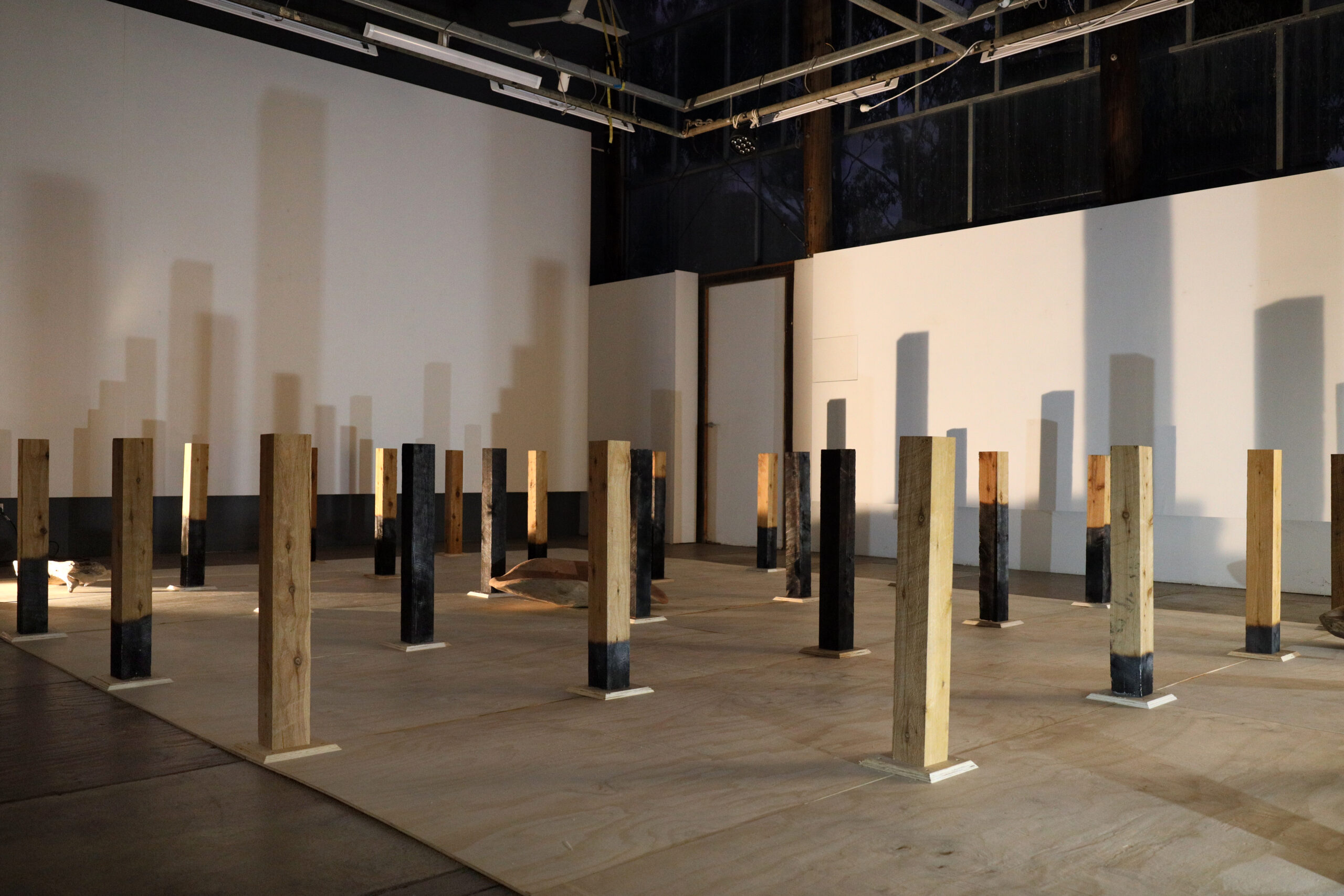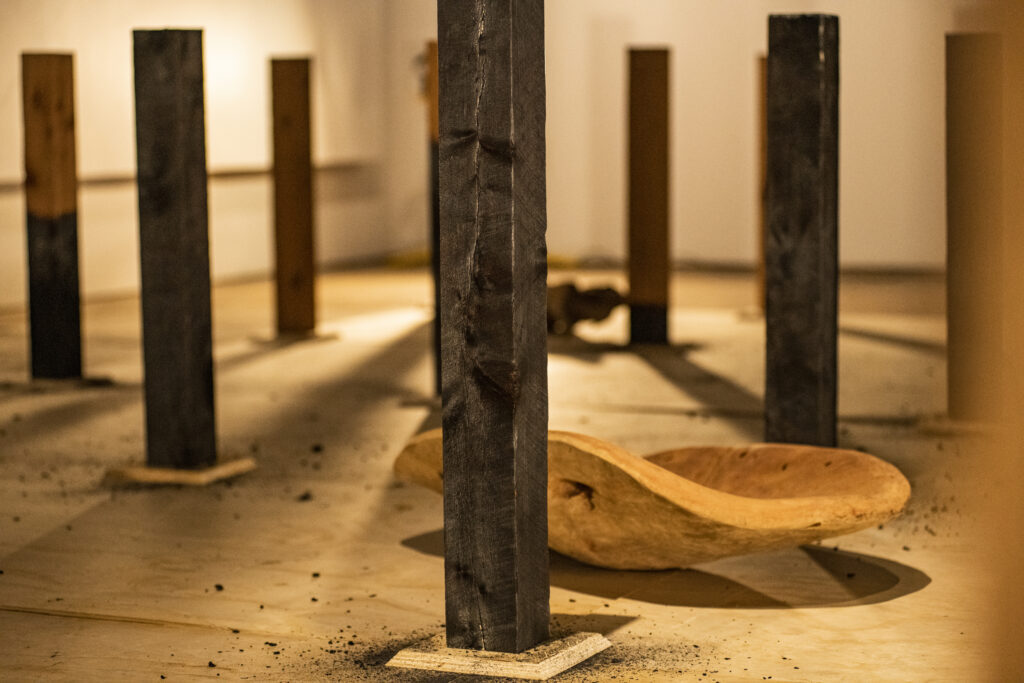Next on the List draws from Alvin’s cultural understanding of climate shift and the impacts of changing land use. It proposes a contemporary and evolving perspective on humans as a species now threatened in our present and future climate change context. Specifically, Alvin brings together elements created in timber and uses pyrography to speak to cultural water carrying practices usurped by white settlement and their irrigation systems on Yorta Yorta Country. Between empty water carrying coolamons, the remnant stumps of settlement on drained swamps marked by the passage of fire stand in vigil over an endangered species. Together they invite reflection on a future context where humans along with their cultural practices—such as water carrying systems and shelters—are next on the endangered list. But look closely. You might find signs of the survival routes used by ‘drought specialist’ species.
Alvin Darcy is a Yorta Yorta, Taungurung man and pyrography artist (freehand burn marking on artefacts, wood, or other materials) through his father, and a Ngarigo, Walbunja man through his mother.
For Next on the List, Alvin took part in a Parched residency on Yorta Yorta Country in late 2022. He also undertook research through Punctum (BEYOND residency) and an exchange program with Situate Labs in lutruwita/Tasmania.

Listen to the Alvin discuss his inspiration for Next on the List
Transcript:
My name is Alvin Darcy Briggs and I currently live in Castlemaine. Castlemaine is on Dja Dja Wurrung Country Shepparton is a part of Yorta Yorta homelands. That’s on my Briggs side.
I did learn a lot through the research. It helped me realise the time that I need. I learnt a lot about Shepparton and the development of Shepparton in general.
There were some works, a couple by some of the local artists. Don Briggs¹ did an acrylic painting of the long neck turtle. Growing up, I was told that the long neck turtle was very important to Central Victoria and that it has evolved and changed over time to what it is today. It’s always intrigued me about the long neck turtle. It was part of an old story about how the waterways changed around Shepparton and the Goulburn River in particular, and how it was changed by a shift in the earth thousands of years ago. It would have had to adapt to the water changes in the area. Further north, the waterways were changed by a geological shift and that changed the direction of the Goulburn River. It would have taken a long time to get back to where it is now. Scientifically, they say it happened around 30,000 years ago, probably in conjunction with terms of drought.
They did have an Indigenous exhibition about the river…local knowledge…and a new installation that was about a midden that was found on the Goulburn River, that Jack Anselmi² has done, that’s been used for…it’s been there for centuries. It has been getting a little bit destroyed by, I think, irregular water flows through the area.
Wooroo³…meaning mouth. That photo was on display too, and that just really spoke to me about the water scarcity in that particular area. It’s pretty much emergency reserves. They were mainly used around drought, and when they were, they were under strict rules and regulations to help adapt to the drought situations. It’s also a part of the Taungurung territory that I’m a part of as well.
I really felt that von Guerard ⁴ really captured the natural beauty of the place in its natural state…before the impacts of settlement. I was mainly happy to see the river in that natural state, really. There was a lot of changes to the river in the area for sure, to help with irrigation of the fruit orchards. Shepparton and was known as the fruit bowl of Australia for a long time.
Well, I started to focus on the swamplands, really. Swamplands are one of the first areas to go through drastic change during the drier weathers. The waters levels were pretty low when we got out there. You can see where the original water levels are and you can tell when the waters are getting low. It changes the life of the local animals. I discovered that swamplands are classified as kidneys of a river system. Since a lot of the area is practically reclaimed land from the swamp lands, after the ground had dried out a bit, people thought the ground was okay to build on. But that’s not the case. As the ground keeps drying out, it can change the structures because the moisture is deep in the earth. So if that moisture deep in the earth is drying out, I think we’re in for trouble.
I’ve moved far away from the original idea that I had before the research. That was one element I liked about the research…to help refine and develop ideas. So now I feel like I’ve peeled it all back to the very basics of what I wanted to say. I’ve tried to whittle my ideas down to two simple elements. I’ve decided to just stick with timber, which speaks a lot about the issues at hand…the ancient trees or the elder trees being cut down…they help keep the ecological system in check. The impacts are still going on today for sure, which add to the impacts of drought.
I plan for it to be laid out into a house shape. I’m just going to have the stumps. When swamplands have been built over the top of and dried out the stumps will shift and change under the conditions so that’s where it can have a big impact on the structures built in that area.
I want to add coolamons, or water vessels. Water carriers that I’ll make myself so as to indicate the presence of my ancestors in the area, and the adaptation that they would have had to utilise to combat drought. They kind of link the story of the past and the present and future at the same time.
The name is ‘Next on the List’. That speaks to species that have gone through the extinction list because of the impacts of human settlement. I wanted to make sure that I could include my ancestors of the area…their plight in the whole thing. I just had in mind that I wanted to incorporate them and I felt that the coolamons were the best way of doing that, and the use that the old people had…just always working with the local timbers and woods.
I want to see how it stands in the gallery. Well, I’d like to see it in its physical form for one to test dimensions…especially if it’s going to be a place for sharing story. Maybe develop it to travel around the local surrounding area, but if it feels right, I would like to see it to go to different places for sure.
- Don Briggs: The Long Neck Turtle (1993)
- Nici Cumpston: Wooroo (mouth) Rock Well, Whroo – Rushworth State Forest (2013)
- Jack Anselmi and Cynthia Hardie: Midden (2016)
- Eugene von Guerard: The Goulburn River, Near Shepparton (1862)
